Inside Tibet people have made the decision not to celebrate Losar this year. It appears to be not just an expression of sorrow for those Tibetan shot, tortured and imprisoned in last years uprising, but also an act of defiance against the Chinese government that wants to show the world that Tibetans enjoy religious and cultural freedoms under its rule. In exile there has been some debate on whether or not to celebrate Losar. There are valid arguments on both sides, but then again the logic of revolution is another thing altogether. When the struggle calls we can only obey.
Earlier I had written a cultural essay for Losar, but then I decided on a a more political gift for Rangzen advocates and activists. The following piece is actually a pamphlet to be distributed on March 10 and future rallies and meeting, but I thought that those who believe in Rangzen might enjoying sitting back with a chang-koe and reading it on Losar day. Most of us have a general idea of the facts that have been presented before the UN and the world, to show that Tibet was an independent country before the Communist invasion: treaties, the Shakabpa passport, the flag and so on. I have tried to provide details that are probably not that well known but which I hope will edify and perhaps even cheer and encourage.
I have attempted to be scrupulously honest with the facts and have provided authentic references for nearly every claim or statement made in the pamphlet. Since the pamphlet had to be kept short, all the references, additional material, related documentation, photographs, maps, illustrations, audio clips and bibliography will be on a website www.rangzen.net. You can access what you want on the section “Independent Tibet – Some Facts” and clicking on the reference number.
The fully laid-out and illustrated pamphlet can be downloaded here (in black & white or colour) and can be printed at home or at a commercial printer. Individuals or organization can print and distribute the pamphlet, and space is provided on the front cover for the organizations credit line. The website will be up in a few days – definitely before March 10.
INDEPENDENT TIBET – SOME FACTS
Compiled by Jamyang Norbu for the Rangzen Alliance
FUNCTIONING STATE
Before the Chinese Communist invasion of 1950 Tibet was a fully functioning and independent state. It threatened none of its neighbors, fed its population unfailingly, year after year, with no help from the outside world. Tibet owed no money to any country or international institutions, and maintained basic law and order. Tibet banned capital punishment in 1913 (mentioned by a number of foreign travelers [1]) and was one of the first countries in the world to do so. There is no record of it persecuting minorities (e.g. Muslims [2]) or massacring sections of its population from time to time as China and some other countries do – remember Tiananmen. Although its frontiers with India, Nepal and Bhutan were completely unguarded, very few Tibetans fled their country as economic or political refugees. There was not a single Tibetan immigrant in the USA or Europe before the Communist invasion.
FOREIGN MILITARY INVASION NOT “PEACEFUL LIBERATION”
On the dawn of 6th October 1950, the 52nd, 53rd & 54th divisions of the 18th Army[3] of the Red Army (probably over 40,000 troops) attacked the Tibetan frontier guarded by 3,500 regular soldiers and 2,000 Khampa militiamen. Recent research by a Chinese scholar reveals that Mao Zedong met Stalin on 22nd January 1950 and asked for the Soviet air force to transport supplies for the invasion of Tibet. Stalin replied: “It’s good you are preparing to attack Tibet. The Tibetans need to be subdued.”[4]
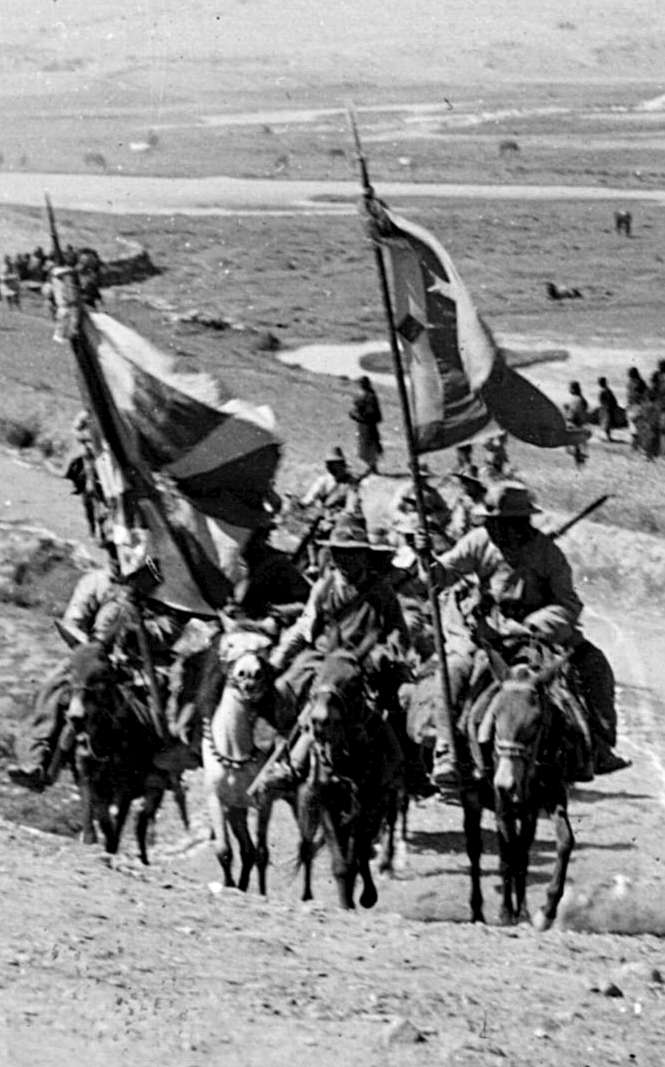 An English radio operator (employed by the Tibetan government) at the Chamdo front wrote that Tibetan forward defences at the main ferry point on the Drichu River fought almost to the last man.[5] In the south at the river crossing near Markham, the Tibetan advance guards fought heroically but were wiped out, according to an English missionary there.[6] Surviving units conducted fighting retreats westwards, in good order. No unit fled or surrendered. Four days into the retreat, one regiment was overwhelmed and destroyed. Only two weeks after the initial attack, the Tibetan army surrendered. The biography of a Communist official states “Many Tibetans were killed and wounded in the Chamdo campaign.” and “… the Tibetan soldiers fought bravely, but they were no match for the superior numbers and better training”[7] of the Chinese forces. According to the only Western military expert who wrote on the Chinese invasion of Tibet “…the Reds suffered at least 10,000 casualties.”[8]
An English radio operator (employed by the Tibetan government) at the Chamdo front wrote that Tibetan forward defences at the main ferry point on the Drichu River fought almost to the last man.[5] In the south at the river crossing near Markham, the Tibetan advance guards fought heroically but were wiped out, according to an English missionary there.[6] Surviving units conducted fighting retreats westwards, in good order. No unit fled or surrendered. Four days into the retreat, one regiment was overwhelmed and destroyed. Only two weeks after the initial attack, the Tibetan army surrendered. The biography of a Communist official states “Many Tibetans were killed and wounded in the Chamdo campaign.” and “… the Tibetan soldiers fought bravely, but they were no match for the superior numbers and better training”[7] of the Chinese forces. According to the only Western military expert who wrote on the Chinese invasion of Tibet “…the Reds suffered at least 10,000 casualties.”[8]
It was not a peaceful liberation of Tibet as Beijing claims. In 1956 the Great Khampa Uprising started and spread throughout the country culminating in the March Uprising of 1959. Guerilla operations only ceased in 1974. “A conservative estimate would have to be no less than half-a-million”[9] Tibetans killed in the fighting. Many more died in the subsequent political campaigns, forced labor camps (laogai) and the great famine. The revolutionary uprisings throughout Tibet in 2008 and the brutal Chinese crackdown clearly demonstrate that the struggle continues today.
NATIONAL FLAG
The modern Tibetan national flag was adopted in 1916.[10] Its first appearance before the world was in National Geographic Magazine’s “Flags of the World” issue of 1934[11] and other publications, and was reproduced in the early thirties in cigarette card collections in Europe.[12]  The flag was probably too new and unknown to appear in the very first flag issue (1917) of the National Geographic, but Tibet did receive mention in an article on medieval flags in that same issue.[13] According to an eminent vexillologist, Professor Lux-Worm, the national flag of Tibet was based on an older 7th century snow lion standard of the Tibetan Emperor, Songtsen Gampo.[14] It should be borne in mind that over 90% of the flags of the nations in the UNO were created after WWII, including the present national flag of China.
The flag was probably too new and unknown to appear in the very first flag issue (1917) of the National Geographic, but Tibet did receive mention in an article on medieval flags in that same issue.[13] According to an eminent vexillologist, Professor Lux-Worm, the national flag of Tibet was based on an older 7th century snow lion standard of the Tibetan Emperor, Songtsen Gampo.[14] It should be borne in mind that over 90% of the flags of the nations in the UNO were created after WWII, including the present national flag of China.
NATIONAL ANTHEM
The old Tibetan national anthem or national hymn, Gangri Rawae or “Snow Mountain Rampart” was composed in 1745 by the (secular) Tibetan ruler Pholanas.[15] It was recited at the end of official ceremonies and sung at the beginning of opera performances in Lhasa.[16] When the Tibetan government came into exile in India, a more modern national anthem, Sishe Pende (“Universal Peace and Benefits”)[17] was composed. The lyrics were written by the Dalai Lama’s tutor, Trichang Rimpoche who was considered a great poet in the classical nyengak (Skt. kaviya) tradititon.
MAPS OF TIBET
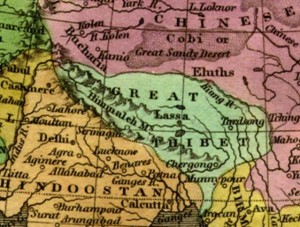 Many pre-1950 maps, globes and atlases showed Tibet as an independent nation separate from China. Some of the earliest maps on record of Asia show Tibet (variably spelled as Tobbat, Thibbet, or the Kingdom of Barantola) as separate from China or Cathay. A map of Asia drawn by the Dutch cartographer, Pietar van der Aa around 1680 shows Tibet in two parts but distinct from China;[18] as does a 1700 map drawn by the French cartographer Guillaume de L’isle, where Tibet is referred to as the “Kingdom of Grand Tibet.” [19] A map of India, China and Tibet published in the USA in 1877 represents Tibet as distinct from the two other nations.[20] An 1827 map of Asia drawn by Anthony Finley of Philadelphia, clearly shows “Great Thibet” as distinct from the Chinese Empire.[21]
Many pre-1950 maps, globes and atlases showed Tibet as an independent nation separate from China. Some of the earliest maps on record of Asia show Tibet (variably spelled as Tobbat, Thibbet, or the Kingdom of Barantola) as separate from China or Cathay. A map of Asia drawn by the Dutch cartographer, Pietar van der Aa around 1680 shows Tibet in two parts but distinct from China;[18] as does a 1700 map drawn by the French cartographer Guillaume de L’isle, where Tibet is referred to as the “Kingdom of Grand Tibet.” [19] A map of India, China and Tibet published in the USA in 1877 represents Tibet as distinct from the two other nations.[20] An 1827 map of Asia drawn by Anthony Finley of Philadelphia, clearly shows “Great Thibet” as distinct from the Chinese Empire.[21]
Probably the largest stained glass globe in the world (in Boston), based on the Rand McNally 1934 map of the world, clearly shows Tibet as a separate nation.[22] (Tibet is in pink above India)
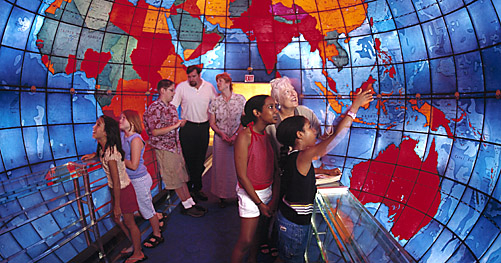 Following the publication of the great atlas commissioned by the Manchu Emperor Kangxi and created by Jesuit cartographers, some European maps in the mid-1700s began to depict Tibet as part of China. The Jesuits could not personally survey Tibet (as they had surveyed China and Manchuria) since Tibet was not part of the Chinese Empire. So they trained two Mongol monks in Beijing and sent them to make a secret survey of Tibet. Similar clandestine surveys of Tibet were conducted by British mapmakers using trained Himalayan natives and even a Mongol monk. An American sinologist has observed that, like European colonial powers, China could be said to have used cartography to further its “Colonial Enterprise” in Tibet and Korea.[23]
Following the publication of the great atlas commissioned by the Manchu Emperor Kangxi and created by Jesuit cartographers, some European maps in the mid-1700s began to depict Tibet as part of China. The Jesuits could not personally survey Tibet (as they had surveyed China and Manchuria) since Tibet was not part of the Chinese Empire. So they trained two Mongol monks in Beijing and sent them to make a secret survey of Tibet. Similar clandestine surveys of Tibet were conducted by British mapmakers using trained Himalayan natives and even a Mongol monk. An American sinologist has observed that, like European colonial powers, China could be said to have used cartography to further its “Colonial Enterprise” in Tibet and Korea.[23]
TIBETAN CURRENCY
Before the Chinese invasion, Tibet had its own currency based on the Tam and Srang denomination system. The earliest coinage used in Tibet was silver and struck in Nepal under a treaty agreement.[24] A joint Chinese-Tibetan currency (the Ganden Tanka) was issued when Manchu forces occupied Tibet. After the Chinese army was expelled in 1912, Tibet minted its own coin using Buddhist and Tibetan designs. Paper currency was only introduced into Tibet in the early 20th century, but according to the numismatist Wolfgang Bertsch, these bank notes were “small works of art.”[25] A unique aspect of Tibetan banknotes was that the serial numbers were handwritten by a guild of specialist calligraphists, the epa, to prevent forgery.
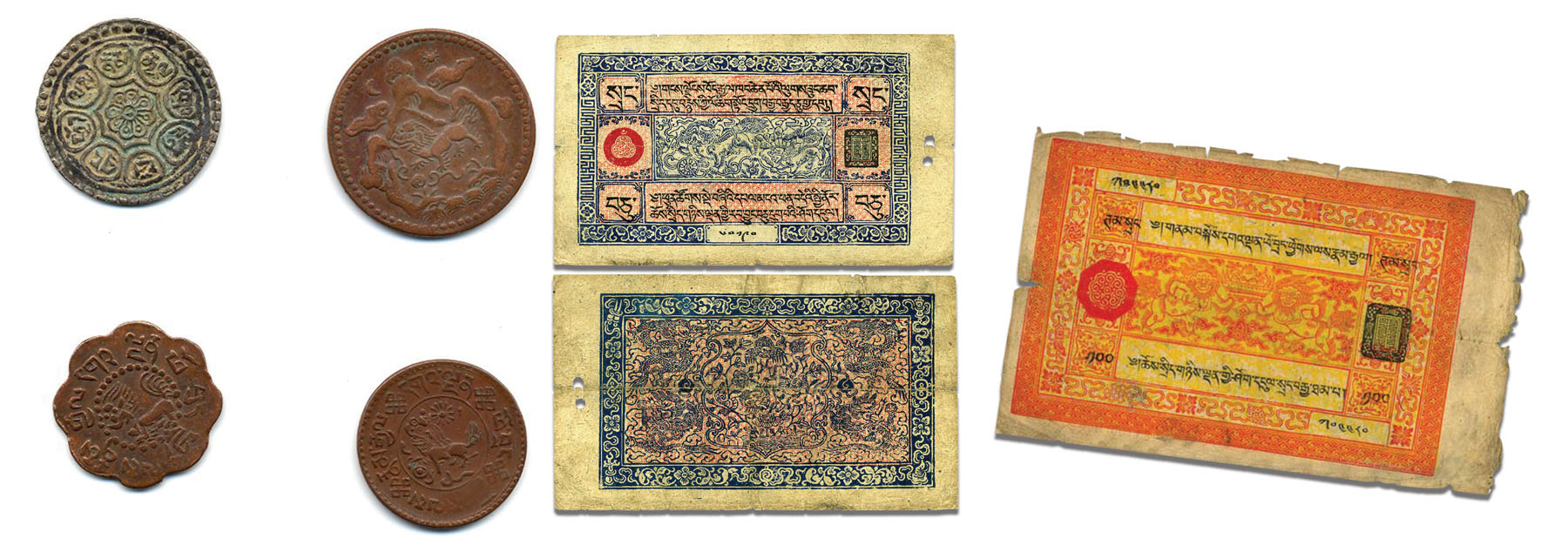 Even after the Communist invasion, Tibetans successfully undermined Chinese efforts to take over its currency. Official Chinese currency only came into use after the departure of the Dalai Lama and the Tibetan government from Tibet in March 1959.26
Even after the Communist invasion, Tibetans successfully undermined Chinese efforts to take over its currency. Official Chinese currency only came into use after the departure of the Dalai Lama and the Tibetan government from Tibet in March 1959.26
TIBETAN PASSPORTS
The Tibetan government issued its own passports to travelers entering its borders or (the few) Tibetans who traveled abroad. Before WWII, the term passports covered visas and travel documents in general. The earliest record of a Tibetan passport issued to a foreign traveler is in 1688 to an Armenian merchant, Hovannes (Johannes).[27]
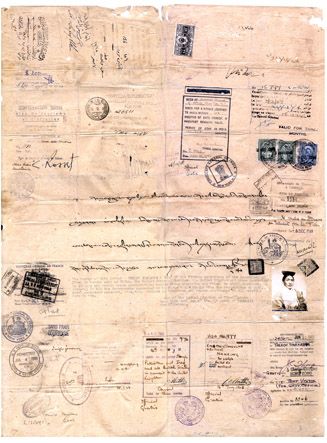 The Tibetan government gave its approval for the first-ever Everest expedition (1921). Charles Bell, the visiting British diplomat in Lhasa wrote “I received from the Tibetan Government a passport in official form, which granted permission for the climbing of Mount Everest.”[28] The subsequent Everest expeditions of 1922, 1924 and 1936[29] also received passports from the Tibetan government. Passports were sometimes issued for scientific undertakings: the Schaeffer expedition of 1939,[30] Tucci’s expedition of 1949 [31] and the plant hunter Frank Kingdon Ward in 1924.[32]
The Tibetan government gave its approval for the first-ever Everest expedition (1921). Charles Bell, the visiting British diplomat in Lhasa wrote “I received from the Tibetan Government a passport in official form, which granted permission for the climbing of Mount Everest.”[28] The subsequent Everest expeditions of 1922, 1924 and 1936[29] also received passports from the Tibetan government. Passports were sometimes issued for scientific undertakings: the Schaeffer expedition of 1939,[30] Tucci’s expedition of 1949 [31] and the plant hunter Frank Kingdon Ward in 1924.[32]
President Roosevelt’s two envoys to Tibet in 1942 were presented their passports at Yatung.[33] The Americans Lowell Thomas Jr. and Sr. visited Tibet in 1949, and were issued “Tibetan passports” at Dhomo. “When the Dalai Lama’s passport was spread out before us, I could not help thinking that many Western explorers who had failed to reach Lhasa would have highly prized a document like this.” [34]
The first modern Tibetan passport [35] with personal information, photograph and space for visas and endorsements was issued in 1948 to members of the Tibetan trade mission. It was modeled on the international one-page fold-out model of 1915. Britain, USA and seven other countries issued visas and transit visas for this document.
TREATIES
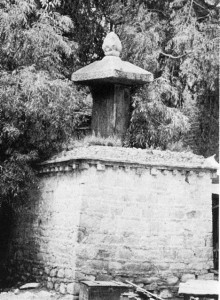 One of the most important treaties between the Tibetan Empire and the Chinese Empire dates back to AD 821-822. The text, carved in Tibetan and Chinese on a stone pillar [36] near the Jokhang temple in Lhasa states that “Great Tibet” and “Great China” would act towards each other with respect, friendship and equality.
One of the most important treaties between the Tibetan Empire and the Chinese Empire dates back to AD 821-822. The text, carved in Tibetan and Chinese on a stone pillar [36] near the Jokhang temple in Lhasa states that “Great Tibet” and “Great China” would act towards each other with respect, friendship and equality.
As an independent nation, Tibet entered into treaties with neighboring states: Bushair 1681, Ladakh 1683 and 1842, Nepal 1856 and so on.
Tibet signed a number of treaties and conventions with Britain culminating in the Simla Treaty of 1914 by which British India and Tibet reached an agreement on their common frontier.[37] India’s present-day claims to the demarcation of its northern border is based on this treaty which was signed by Tibet – not China.
In January 1913, Tibet and Mongolia signed a treaty in Urga, the preamble of which reads: “Whereas Mongolia and Tibet having freed themselves from the Manchu dynasty and separated themselves from China, have become independent states, and whereas the two States have always professed one and the same religion, and to the end that their ancient mutual friendships may be strengthened…”[38] Declarations of friendship, mutual aid, Buddhist fraternity, and mutual trade etc. follow in the various articles. The Tibetan word “rangzen” is used throughout to mean “independence”.
A Tibetan Bureau of Foreign Affairs was established in 1942, which conducted diplomatic relations (and correspondence[39]) with Britain, USA, Nepal, independent India and China.
POST & TELEGRAPH SYSTEM
The modern Tibetan postal system was built on the older messenger system of the early Tibetan Empire and the later Mongol courier system. A Post and Telegraph Office (dak-tar laykhung) was created in 1920.[40] Postage stamps of various denominations were indigenously designed and hand-printed, and which are now collector’s items.[41] Though not a signatory to the International Postal Treaty, a system was created so that letters from Tibet could be delivered to foreign addresses, and letters from abroad be delivered inside Tibet.
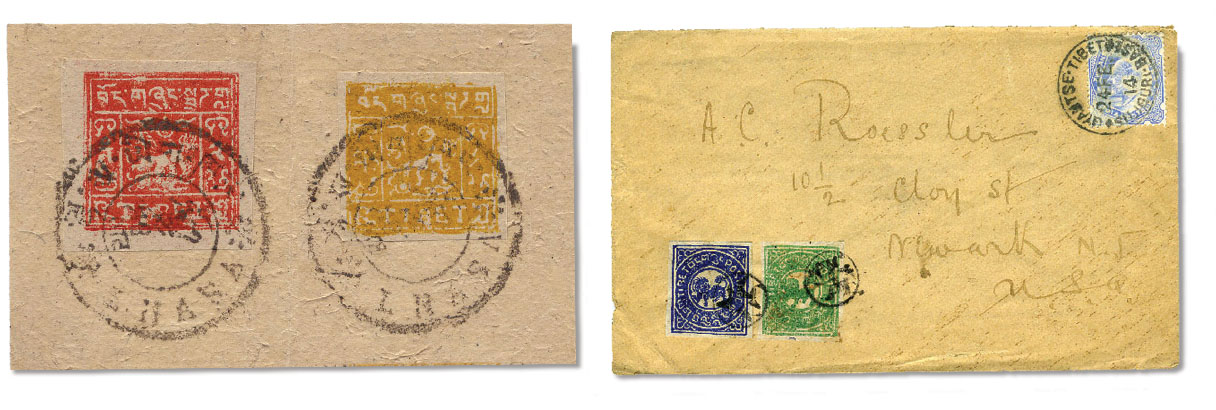 Spencer Chapman, visiting Lhasa in 1936, declared that “the postal and telegraph system is most efficient.”[42] The same system continued for a period after 1950. The Czech filmmaker Vladimir Cis had a letter from his family in Prague delivered to him in the wilderness of Tibet by a postal runner.[43]
Spencer Chapman, visiting Lhasa in 1936, declared that “the postal and telegraph system is most efficient.”[42] The same system continued for a period after 1950. The Czech filmmaker Vladimir Cis had a letter from his family in Prague delivered to him in the wilderness of Tibet by a postal runner.[43]
A telegraph line from India to Lhasa was completed in 1923, along with a basic telephone service.[44] Both were open for public use. The Tibetan capital was electrified in 1927. The work of installing both the hydroelectric plant and the distribution system was undertaken near “single-handedly”[45] by a young Tibetan engineer, Ringang. All these projects were initiated and paid for by the Tibetan government. Radio Lhasa was launched in 1948 and broadcasted news in Tibetan, English and Chinese.[46]
WITNESSES TO INDEPENDENT TIBET
The fact that Tibet was a peaceful, independent country is attested to by the writings of many impartial western observers [47] who not only visited pre-invasion Tibet, but even lived there for considerable periods of time – as the titles of some of their memoirs seem to proudly proclaim: Twenty Years in Tibet (David McDonald)[48], Eight Years in Tibet (Peter Aufschnieter)[49], Seven Years in Tibet (Heinrich Harrer)[50]. The premier scholar on Tibet, Hugh Richardson lived for a total of eight years in Tibet, and his many writings[51] reveal a country that was functioning, orderly, peaceful and with a long history of political independence and cultural achievement. Another great scholar and diplomat, Charles Bell, regarded as the “architect of Britain’s Tibet policy,” was convinced that Britain and America’s refusal to recognize Tibetan independence (but which they sometimes tacitly acknowledged when it was to their advantage) was largely dictated by their desire “to increase their commercial profits in China.”[52]
It is almost certain that none of the official propagandists who demonize Tibet in Chinese publications had witnessed life in old Tibet. In fact, none of Beijing’s Tibet propagandists in the West (Michael Parenti, Tom Grunfeld, Barry Sautman et al)[53] had visited Tibet before 1980. They often misrepresent the old Tibetan society and government with select quotes from English journalists and officials (L. A. Waddell, Percival Landon, Edmund Candler, Captain W.F.T. O’Connor) who accompanied the British invasion force of 1904, and who sought to justify that violent imperialist venture into Tibet by demonizing Tibetan society and institutions.
The only high-ranking Chinese official with scholarly credentials who spent any length of time in old Tibet was Dr. Shen Tsung-lien, representative of the Republic of China in Lhasa (1944-1949). In his book Tibet and the Tibetans, Dr. Shen writes of a nation clearly distinct from China, and one that “…had enjoyed full independence since 1911.” He writes truthfully of a hierarchical, conservative society “fossilized many centuries back” but whose people were orderly, peaceable and hospitable – but also “notorious litigants,” adding that “few peoples in the world are such eloquent pleaders.” Shen also mentions “Appeals may be addressed to any office to which the disputants belong, or even to the Dalai Lama or his regent.”[54]
Reference Notes. (the expanded version will be on the website)
Bell, Charles. Tibet Past and Present. London: Oxford University Press, 1924. See index:
“Capital punishment abolished in Tibet, 142, 143, 236.”
Byron, Robert. First Russia then Tibet. London: Macmillan & Co., 1933. pg 204: “Capital
punishment was now abolished.”
McGovern, William. To Lhasa in Disguise. New York: Century Co., 1924. pg 388-389.
Kingdon-Ward, Frank. In the Land of The Blue Poppies. New York: Modern Library, 2003. pg 22.
Winnington, Alan. Tibet: The Record of a Journey. London: Lawrence & Wishart Ltd., 1957.
2 Henry, Gray. Islam in Tibet. Louisville, Kentucky: Fons Vitae, 1997.
Nadwi, Dr. Abu Bakr Amir-uddin. Tibet and Tibetan Muslims, Dharamsala: Library of Tibetan
Works & Archives, 2004.
3 Goldstein, Melvyn. A Tibetan Revolutionary: The Political Life and Times of Bapa Phuntso
Wangye. University of California Press, 2004, pg 137
4 Chang, Jung & Jon Halliday. Mao: The Unknown Story. London: Jonathan Cape, 2005.
5 Ford, Robert. Captured in Tibet. London: George G. Harrap & Co., Ltd, 1957. pg 158.
6 Bull, Geoffrey T. When Iron Gates Yield. London: Hodder & Stoughton, 1955. pg 130.
7 Goldstein, Melvyn. A Tibetan Revolutionary: The Political Life and Times of Bapa Phuntso
Wangye. University of California Press, 2004, pg 139.
8 O’Ballance, Edgar. The Red Army of China. London: Faber & Faber, 1962. pg 189-190.
9 Norbu, Jamyang. “The Forgotten Anniversary – Remembering the Great Khampa Uprising of
1956″. Thursday, December 07, 2006, Phayul. https://www.phayul.com/news/article.aspx?id=14993&t=1&c=4
10 Tsarong, Dundul Namgyal. In the Service of His Country: The Biography of Dasang Damdul
Tsarong Commander General of Tibet. Ithaca: Snow Lion Publications, 2000. pg 51
11 Grosvenor, Gilbert and William J. Showalter, “Flags of the World”. The National Geographic
Magazine: September, 1934 – Vol. LXVI – No. 3. Washington, D.C.” National Geographic
Society, 1934.
12 Tibet Nationalflagge, Bulgaria Zigarettenfabrik, Dresden,1933. (From a series non-European countries, pictures 201-400) Courtesy of Prof. Dr. Jan Andersson.
13 Grosvenor, Gilbert H. “The Heroic Flags of the Middle Ages.” The National Geographic
Magazine: October, 1917 – Vol. Xxxii – No. 4. Washington, D.C.: National Geographic
Society, 1917.
14 Lux-Wurm, Pierre C. “The Story of the Flag of Tibet.” Flag Bulletin: Vol. XII – No. 1. Spring
1973.
15 OLD TIBETAN NATIONAL HYMN
Ghang ri rawe kor we shingkham di
Phen thang dewa ma loe jungwae ne
Chenrezig wa Tenzin Gyatso yin
Shelpal se thae bhardu
Ten gyur chik
Circled by ramparts of snow-mountains,
This sacred realm,
This wellspring of all benefits and happiness
Tenzin Gyatso, bodhisattva of Compassion.
May his reign endure
Till the end of all existence
(my translation)
The eminent Tibetan scholar, Tashi Tsering citing the historical work Bka’ blon rtogs brjod, says that this verse was composed by the Tibetan ruler, Phola lha nas, (in 1745/46) in praise of the 7th Dalai Lama. “Reflections on Thang stong rgyal po as the founder of the a lce lha mo tradition of Tibetan performing arts,”The Singing Mask: Echoes of Tibetan Opera, Lungta Winter 2001 No 15, eds. Isabelle Henrion-Dourcy and Tashi Tsering)
16 Audio clip of namthar (opera aria) of National Hymn sung by Techung. Courtesy of Chaksampa
17 TIBETAN NATIONAL ANTHEM
Sishe phende dhoe gu jung wei ter
Thubten sampel norbu honang bar
Tendro nor dzin gyache kyong wey gon
Trinle kyi rolsto gye
Dorje kham sum tenpey
Chok kun jham tse kyong
Nam khoe gawa gyaden u pang gungla beg
Phuntso deshi nga thang gye
Bhojong cholkha sum gyi kyonla deyden sar pey khyap
Chosi kyi pelon tar
Thubten chochu gyepe dzamling yangpi kyegu shidi pela jor
Bhojong tendro getzen nyi woe kyi
Tashi woe nang humdu tro mi zi
Nachoe munpey yul ley gye gyur chi
TIBETAN NATIONAL ANTHEM (Translation)
The source of temporal and spiritual wealth of joy and boundless benefits
The Wish-fulfilling Jewel of the Buddha’s Teaching, blazes forth radiant light
The all-protecting Patron of the Doctrine and of all sentient beings
By his actions stretches forth his influence like an ocean
By his eternal Vajra-nature
His compassion and loving care extend to beings everywhere
May the divinely appointed rule achieve the heights of glory
And increase its fourfold influence and prosperity
May a golden age of joy and happiness spread once more through the three regions of Tibet
And may its temporal and spiritual splendour shine again
May the Buddha’s Teaching spread in all the ten directions and lead all beings
in the universe to glorious peace
May the spiritual Sun of the Tibetan faith and People
Emitting countless rays of auspicious light
Victoriously dispel the strife of darkness
Lyrics composed in 1959 by Kyapje Trichang Rinpoche, tutor of His Holiness the Dalai Lama.
18 Image. A map of Asia drawn by the Dutch cartographer, Pietar van der Aa around 1680 shows
Tibet in two parts but distinct from China.
19 Image. A map of Asia drawn by the French cartographer, Guillaume de L’isle, around 1700,
where Tibet is referred to as the “Kingdom of Grand Tibet.”
20 Image. “Map of Hindoostan, Farther India, China and Tibet”. Constructed & engraved by
W.Williams, Phila. Entered according to Act of Congress in the year 1877 by S Augustus
Mitchell in the Office of the Librarian of Congress at Washington.
21 Image. An 1827 map of Asia drawn by Anthony Finley of Philadelphia, clearly showing “Great
Tibet” as distinct from the Chinese Empire.
22 The Mapparium, is a thirty-foot stained-glass globe room in the lobby of the Christian Science
Publishing Society in Boston, which gives one a unique “inside view” of the world. The
political boundries are frozen circa 1935. It was based on Rand McNally’s 1934 map
of the world,. At this size, the scale amounts to approximately 22 miles to the inch.
In the photograph Tibet (pink) can be seen directly at the back above British India (red)
and to the side of China (yellow).
Check URL for history and directions. http://www.roadsideamerica.com/story/11455
http://designorati.com/articles/t1/cartography/329/mary-baker-eddys-marvelous-mapparium.php
23 Hostetler, Laura. Qing Colonial Enterprise: Ethnography and Cartography in Early Modern
China. Chicago: University of Chicago Press, 2001.
24 Bertsch, Wolfgang. The Currency of Tibet. Dharamsala: Library of Tibetan Works & Archives, 2002.
25 Bertsch, Wolfgang. A Study of Tibetan Paper Money: With a Critical Bibliography, Dharamsala: Library of Tibetan Works & Archives, 1997.
26 Rhodes, N.G. “The First Coins Struck in Tibet”. Tibet Journal. Winter 1990: (LTWA), Dharamsala.
27 Richardson, Hugh. “Reflections on a Tibetan Passport”. High Peaks Pure Earth: Collected
Writings on Tibetan History & Culture. London: Serindia Publications, 1998. pg 482.
28 Bell, Charles. Portrait of a Dalai Lama: The Life and Times of the Great Thirteenth. Boston:
Wisdom Publications, 1987. pg 278.
29 Gould, B.J. The Jewel in the Lotus: Recollections of an Indian Political. London: Chatto &
Windus, 1957. pg 210-211.
30 Englehardt, Isrun. Tibet in 1938-39: Photographs from the Ernst Schafer Expedition to Tibet. Chicago: Serindia, 2007. pg 121.
31 Tucci, Guiseppe. To Lhasa and Beyond. New Delhi: Oxford and IBH, 1983. pg 14-15.
32 Cox, Kennith. Frank Kingdon Ward’s, Riddle of the Tsangpo Gorges. United Kingdom: Antique Collector’s Club, 2001. pg 75.
33 Tolstoy, Lt.Col. Ilia. “Across Tibet From India To China”. The National Geographic Magazine. Washington, D.C.: National Geographic Society, August 1946. “This letter was a piece of red cotton cloth about 16 inches wide and two feet long, to be carried in the bosom or on a staff by an outrider who would precede the party by one or two days. It stated that two American officers were en route to visit the Dalai Lama…”
34 Thomas, Lowell Jr. Out of This World: Across the Himalayas to Forbidden Tibet. New York: The Greystone Press, 1950. pg 79-80.
35 Facsimile of Shakabpa passport
36 Photograph. Treaty Pillar of AD 821-822 within protective enclosure.
37 The Sino-Indian Boundary Question (Enlarged Edition). Peking: Foreign Language Press, 1962. Photostat of eastern sector of original map of the McMahon line with signatures and seals of Tibetan and British plenipotentiaries, Delhi 24 March 1914. Original scale 1:5000,000.
38 Facsimile of the Tibet-Mongolia Treaty of 1913, and English translation.
39 Facsimile of Tibetan Foreign Bureau letter (and English translation) to Mao Tse-tung in 1949 .
40 Waterfall, Arnold C. The Postal History of Tibet. London: Robson Lowe Ltd., 1965.
41 Images of Tibetan stamps and covers.
42 Chapman, F. Spencer. Lhasa the Holy City. London: Chatto and Windus, 1940. pg 87.
43 Cis, Peter. Tibet, Through the Red Box. New York: Francis Foster Books, 1998.
44 David, MacDonald. Twenty Years in Tibet. New Delhi: Vintage Books, 1991. (first published 1932). pg 287.
45 Tsarong, Dundul Namgyal. In the Service of His Country: The Biography of Dasang Damdul
Tsarong Commander General of Tibet. Ithaca: Snow Lion Publications, 2000. pg 62.
46 Brauen, Martin. Peter Aufschnaiter’s Eight Years in Tibet. Bangkok: Orchid Press, 2002.
In 1948, Radio Lhasa started the first of its daily broadcasts to the outside world. At five p.m., the station would go on air. The news was read in Tibetan, and then in English by Reginald Fox or by Kyibuk, one of the surviving Rugby students and an official at the Tibetan Foreign Bureau. Finally, the news was read in Chinese by Phuntsok Tashi Takla, the Dalai Lama’s brother-in-law. Official announcements were also read over the radio, as this one prepared by Aufschnaiter:
“We have the honour to announce that Radio Lhasa will broadcast an announcement of the enthronement of His Holiness the Dalai Lama, the ruler of Tibet, together with a proclamation of the Tibetan government to the Tibetan people and the world, on Friday 17 November 1950, at 5.45 p.m. Indian Standard Time.”
47 Statement by Westerners who visited Tibet before 1949 (London13 September 1994). Mr Robert Ford, Mrs Ronguy Collectt (daughter of Sir Charles Bell), Dr Bruno Beger, Mr Henreich Harrer, Mrs Joan Mary Jehu , Mr Archibald Jack, Prof. Fosco Maraini and Mr Kazi Sonam Togpyal of Sikkim. http://www.tibet.com/Status/statement.html
48David, MacDonald. Twenty Years in Tibet. New Delhi: Vintage Books, 1991. (first published 1932). pg 287.
49 Brauen, Martin. Peter Aufschnaiter’s Eight Years in Tibet. Bangkok: Orchid Press, 2002.
50 Harrer, Heinrich. Seven Years in Tibet. London: Rupert Hart Davis, 1953.
51 Richardson, H.E. High Peaks Pure Earth: Collected Writings on Tibetan History & Culture. London: Serindia Publications, 1998.
Richardson, H.E. Tibet and Its History. London: Oxford University Press, 1962.
Richardson, H.E. and David Snellgrove. A Cultural History of Tibet. London: George Wiedenfeld & Nicholson,1968.
52 Bell, Charles. Portrait of a Dalai Lama: The Life and Times of the Great Thirteenth. Boston: Wisdom Publications, 1987. pg 396.
53 Norbu, Jamyang. “Running-Dog Propagandists” Phayul.com, [Monday, July 14, 2008 09:37], http://www.phayul.com/news/article.aspx?id=21945&article=Running-Dog+Propagandists+-+Jamyang+Norbu&t=1&c=4
54 Shen, Tsung-lien and Shen-chi Liu. Tibet and the Tibetans. California: Stanford University Press, 1953. pg 112.


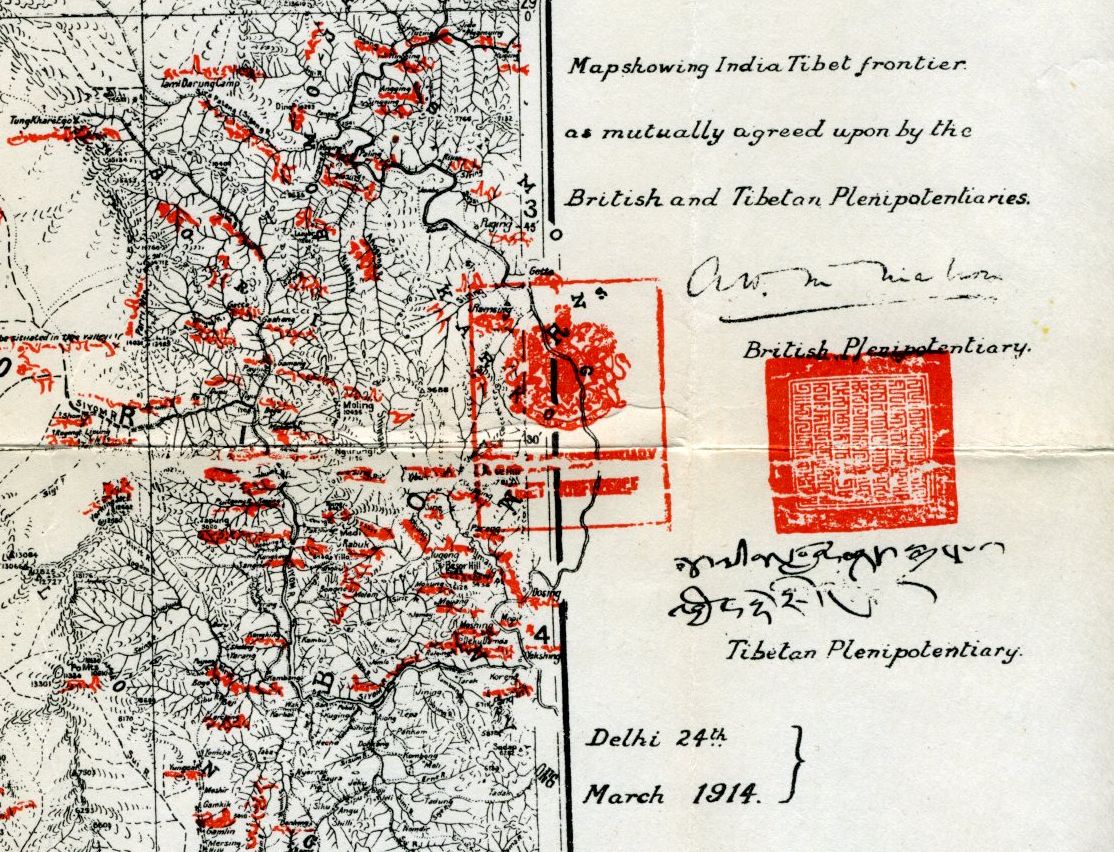
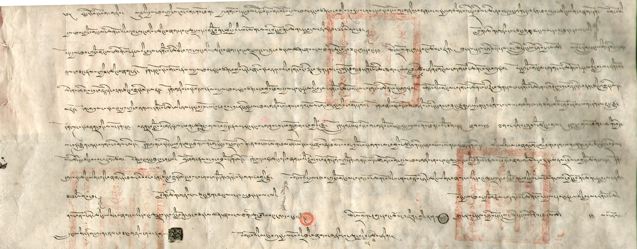
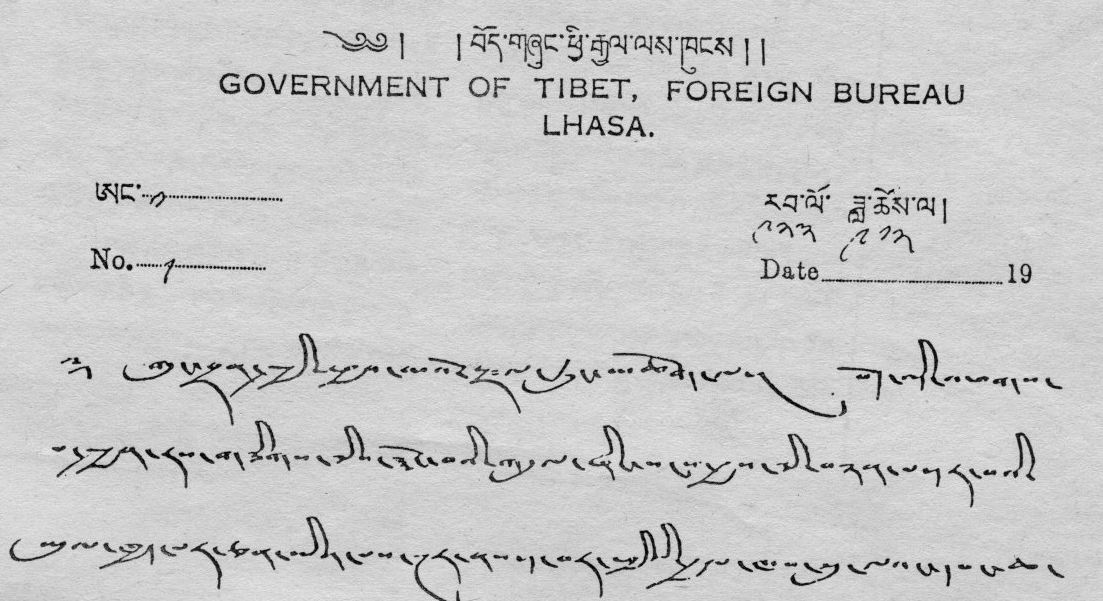


One of the best Losar gifts ever!
So uplifting and informative.
YES RANGZEN!
Thank you
TCL
A wonderful gift for Losar for all the Tibetan people and we, your Inji supporters.
After this sombre Losar, I look forward to joyous Losars to come.
Indeed a wonderful gift for the Tibetan people who are forgoing the Losar celebration to remember the innocent people killed in Tibet last year and to commemorate 50 years of Tibetans coming into exile.
It must be borne in the minds of every Tibetan people that Tibet deserves to be an independent country, free from this tyranical rule that we know as China.
Highly researched, crystallized, and distilled piece of article for historical record.
Everyone, archive!!
I am looking forward to the detailed research, cant’ wait!
Bog Gyalo!
NG
Jamyang la, please keep yourself fit and healthy as we need you more than ever.
It is indeed a great gift for losar and especially for the upcoming 50th march 10th national uprising day. It sure would take a long time to read all those sources you listed at the bottom but I guess one book at a time is the way to go. Thanks for the gift, Jamyang La.
And Tashi la, don’t worry, Jamyang la can still outbench most youngsters on any given day. hehe
Geat piece of gift for Losar.
Thanks
Dear Jamyang Norbu la
In the case of Treaty signed by Tibetan representatives and Mongolic representatives in Janaury 1913 in Urga, it was supposed to be have singnatures from all representatives from Tibetan side and Mongolian side,but there are only three signatures appeared on the treaty paper.
why other representatives didnt give their singnature ? do you have any evidence about this ?
share with us if you know more about it.
Thanks
This is such an excellent tool. Short, easy to read (for those of us with limited attention span). Adding the historical photos is absolutely fantastic (seeing is believing), so none can doubt, especially when china apologist and the confused (maybe slightly deranged) start trying explain things away.
Btw the 8 page booklet is a beautiful thing, design is amazing, so easy to download, print, read and hand out, it’s “mind blasting!”.
Phuntsok,
From where did you download the booklet? May I have the link? Please.
Sorry, the download links have finally been added at the beginning of this post (4th paragraph).
Cheers
Thank you, Golok.
Jamyang la
I am waiting for your reply.
Dude! it has just been one day, come on now. And it is losar. sheshhhh.
Thank you so much Jamyang Norbu la. I was looking for an abridged article summarizing the key points that prove Tibetan independence before 1950 to be given to my chinese friend to read. Your gift could not have come at a better time.
Jamyang Norbu la,
This brochure is most excellent for educating the free world about Tibet’s historical independence. However, in terms of educating the Communists, the brochure would be more effective if you could outfit it with a small explosive device that detonates only at the touch of a red Chinese hand, if not a magical mantra to remove demonic influences. Since that may be beyond your ability, nice work!
Prescott for Patel
p.s. will the paranoid Communists begin searching stacks of literature for minute, CIA-developed explosives? One must sometimes laugh at the stupidity and fear behind fascism.
Hi Sharma,
Ha, ha, ha.
Sharp sarcasm!
Hats off to you.
TCL
Dear Jamyang Norbu la,
I would like to bring your kind attention to the latest Losar Gift from Tibet. I’m refering to the protest of 100 monks of lutsang monastery, Mangra Amdo. As reported in RFA article link http://www.rfa.org/english/news/tibet/tibet-march-02262009163337.html
What really strike me most was here we’ve the the only picture avialable of the most recent protest inside Tibet. In no way I mean to undermine other protest happened in lithang , Nagba and other places.
Second looking at the picture carefully all the monks head were covered by their shawl and that really gives me a strong visual impact. And it says a lot without uttering a word. An idea would be during this year 10 march protest, tibetan every where can riproduce the scenario as a tribute to all the courages and anonymous tibetans killed, tortured or simply vanished.
Third in their appeal one piont goes like their peace vigil manifestation is a gift to every tibetans!!!
I think the level of protest in tibet has reached a high level in their content and appearance.
Bod gyalo
Jamyang la, you mentioned that according to Tashi Tsering, the old Tibetan hym/verse was composed by the Tibetan ruler, Phola lha nas in 1745/46. If that is the case, how comes that the verse mentions about tenzin Gyatso, the XIV Dalai Lama? Just curious. I guess the original one carries VII Dalai Lama’s name.
Thank you Jamyangla for this very special Losar gift, for being the beacon of hope, for keeping the faith and not giving up after the ‘Special Meeting’!
jamyang norbu,
to quote you “Before the Chinese Communist invasion of 1950 Tibet was a fully functioning and independent state”. here is the greatest historical error being accepted and practiced even by staunch tibetan independence activitist like you. the offical statement issued by shakapa at the time when pleading for international support ran like this ” after crossing drichu the chinese army stated invading tibet” from this it implies that those tibetan areas to the east of drichu were not part of the tibetan nation. was west drichu part of china? or was there a nation called kham between tibet and china? if there was no such thing as kham nation then why didn’t tibet issue a statement saying that china started invading tibet from dartsedo in 1949. so politically we dont lose land 2/3 of tibet proper. remember it’s a fact that china started attacking amdo in 1949. why was this fact not on record in the tibetan official statement? why is this fact ignored even today? now i wonder if amdo was a part of tibet.
waiting for your rejoinder.
Tsering Choedon Lejotsang,
Thanks for the hats off. According to the Communists, if we lift our hats there is the danger of exposing our horns, not to mention what must be our black tongues of Rangzen! However, being an orthodox and avid follower of Tibetan lore, what truly amazes me is that Hu Jintao is neither possessed of horns, nor a black tongue. I must conclude, therefore, that we are dealing with a new race of incarnate demons, ones who have gained the ability to hide all external manifestations of their demonhood.
They appear as flesh and blood men, like specters from a horror flick. In fact, their torture, rape, brutality, and murder confirms that they are subhuman demons deserving of….some grim fate, it must be….
I am presently working with the secret reincarnation of Lhalung Peldor on the aforementioned minute explosives, receiving limited support from the small group….well, let’s let the Communists worry about who is supporting me!
These explosives are undetecable as they appear in the form of words and letters, detonate only in the hands of Communist torturers, and are composed of nothing other than explosive and undetectable paper. This has struck fear into the hearts of the Communists. Already terrified by the capacity of literacy to infect people with knowledge and creative thought, the Communists must now contend with letters that actually explode, taking off noses and fingers. No longer are Tibetan patriots the only ones who lose extremities.
Any Communist who opens a book is at risk (of course this means that only the minority who are able to read need worry — but we’ll work on getting the illiterate ones at a later date).
The only safe haven is the complete obliteration of all good literature in China (a project the Communists are doing fairly well at, unfortunately). But we’re now planning on inserting the alphabet explosives into red books! Ha ha ha.
Sadly, we have yet to find a way to target the head of Hu Jintao. The problem is that, being so far up his a**, his head is a difficult target. He doesn’t read widely either, which makes it harder. We have thought of rectally inserting the explosive freedom literature into the head of state, but have yet to find a reliable way to access his toilet. I’m trying to bribe his gay lover to do the deed for me.
I’ll keep you posted on how that goes.
By the way, my peaceful supporter Prescott has a favorite quote that is appropo when I write like this: “Surrendering to atrocity is a more grievous act of violence than the bloodshed inherent in any struggle for freedom.”
Prescott for Patel, for Rangzen.
A Humble Proposal
It is with great pain and difficulty that I, Patel, must explain why I am asking the Communist Chinese to execute the 5 million or so Tibetans remaining on this earth. Before you, the reader, criticize my plan, please give me the benefit of the doubt.
It is utterly impossible for Tibetans to surrender the freedom struggle. No one has the right to ask Tibetans to become a part of the same dictatorship that has brutalized them for more than 50 years. However, the nonviolent movement becomes increasingly challenged in effecting change in Tibet, due to the onslaught of Han Chinese immigration.
The future of Tibet seems, at this point, to hold little more than continued torture, rape, and slow death for the Tibetan people. Therefore, I am asking the Communist Chinese, rather than raping the nuns and torturing the monks, simply to begin the systematic execution of every person of Tibetan descent.
This will offer a variety of benefits. It seems that human rights abuses offer an insufficient ground for the world to seriously engage the Tibet issue. Mere brutality will not suffice in moving the conscience of the world. Indeed, the United Nations did not even see fit to send a fact finding mission to Tibet when Tibetans were gunned down for peacefully protesting. What we need is a well publicized Major Holocaust to get the world’s attention.
Once the Communists launch a more thorough variety of whole scale ethnic cleansing, this will sufficiently aggravate the situation. Right now, we have merely registered a minor Holocaust — which appears to be an impotent claim in the eyes of the world. What we need is a Major Holocaust where the Chinese explicitly affirm their intention to murder every last one of the Tibetans. It is only at this point that the world will stand up for Tibet.
I also believe that the complete extermination of the Tibetan people is in the best interests of human rights. Most of us would much prefer death to cattle prod rapes, torture, and slow lynchings. Therefore, not only would the suggested Major Holocaust garner support for the oppressed Tibetan people, but it would be a more humane reaction than the present Chinese policy.
Therefore, I, Patel, am asking all moderate Communists to desist from reforming the Communist Party, and rather to initiate an immediate and complete extermination of the Tibetan race. This is the only way to generate a slim chance to save the Tibetan people, culture, and religion (ironic, is it not?).
Since Hu Jintao and his comrades have demonstrated repeatedly, as Communists, that they take great joy in rape and torture, I realize I am asking them to give up a part of their fun — their hobby, if you will. I only hope that the satisfaction in letting the blood of the remaining 5 million Tibetans will be enough for the head of China, and all his earnest Comrades.
Sincerely and warmly yours,
Sharma Patel (with aid of Mr. Prescott)
Patel like to take the survey here of all red blooded Tibetan:
please post your answer here:
“What do you longing to give Hu Jintao this Losar?”
Please be creative!
Picture of Mao, Deng, n Zhu De suffering in hell!
personal wish lists follow?
On the 10th day of Losar, I gave to Hu Jintao,
1 cattle prod
2 mortar shells
3 cannon balls
4 hand cuffs
5 martyred bodies
6 charred temples
7 torn pechas
8 fake “negotiations”
9 trampled malas
and a white dove in a dead tree.
He was really happy. Hu said he could now:
1) rape a nun
2) bomb Drepung
3) destroy Sera
4) torture lamas
5) spit on corpses
6) destroy the Dharma
7) force feed Maoism
8) fool Tibetans
9) revive the red book
and pretend to negotiiiiiiiiiiiate.
But on the 11th day of Losar I gave him:
1 uppercut
2 left crosses
3 right hooks
4 round kicks
5 arm bars
6 knuckle sandwhiches
7 broken ribs
8 missing teeth
9 trampled toes
and let my hawk eat his fake white dove.
And I was happy.
Why o why do Patel make the fight personal against Hu Jintao?
1) 1987 martial law
2) defense of raped nuns
3) defense tortued monks
4) defense shot down children
5) 6,000 temples
6) 1.2 million bodies
7) surviving Dharma
8) the trampled culture
9) no human rights
10) and the existence of a single cattle prod.
Patel not make it personal. It IS personal. Hu Jintao more than a symbol but also is devil incarnation. Tulku of demon-being. No use man.
It is personal. This man have power to stop rape and torture. Let us not even talk about our right to Rangzen in Tibet. This man have power to stop rape and torture, but DOING NOTHING.
SO IT IS PERSONAL.
-Patel alone
Jamyang La, Thank you very much for the Losar gifts to every Tibetans and our friends. You inspires us from a very long time both intellectually and practically. Your documentary archieves/collection of a independent TIBET is an eye opener for the world community. Please keep continously your great work. Thank you again ..Bhod- Gyalo !! May you always have a good health & long life …..
How about having you among the Special Reps of HHDL to talk with Chinese govt?
You are the most deserving intectual which makes sense.
Hello …Kashag !!
Why would Jamyang Norbu talk to the Chinese government? What would he, or most of the people on this site, have to say to them? I think I can safely say most of us are in agreement that it’s beneath us to talk to rapist murderers who torture with merciless impunity. I can also safely say that communication with the Chinese Communists is an exercise in futility. They aren’t honest enough or logical enough to merit the investment of time and energy. I think I can also safely say that we want an independent Tibet, NOT a compromise from the PRC that puts every Tibetan under their ugly red flag. The only reason I would support Jamyang Norbu going to talk with China would be if we could make it a planned protest where he punched the Chinese negotiators in their dirty mouths, repeatedly, and got it captured on camera to inspire massive resistance agains the demon-men who occupy Tibet under the pretext of “liberation”!
Are you up for it, Jamyang la? Will you give the Chinese negotiators the old right cross, or surprise your man with a sneaking left hook? Now that kind of negotiation, we will support!
On the other hand, networking with Chinese democracy activists would be very powerful and merit the time and energy demanded for a cohesive front against the legions of red barbarian Communists.
-Prescott and Patel
I have a personal requestion to JN, if feel nice to follow, please do it, otherwise, just ignore this post.
I had already printed out five booklets and I need to staple them tonight. What I realized is, there is no reference or bibliography on the pdf format of “Rangzen Gift”. I think the bibliography is important so that people knew where it came from, it even might inspire people to read the book as well. The indexed number in the article will have a context.
Thank you for your dedicated and selfless work!
Bod Gyal Lo
NG
Newgeneration,
The problem with the booklet was just trying to keep it short enough to fit on two sheets of A4 paper. I think a good bibliography is important and we will put one together in the near future and have it up on the website so that people can use it. Thanks for the idea. I also commend you for taking the personal initiative to print booklets and distribute them. JN
very very helpful information for we researchers.i will send this link to all my indian friends who debate on the issue without having preliminary knowledge. thanks norbu ji.
Tibet was an independent state prior to chinese agression. The govt in exile should knock the U. N. O for justice, so that the Chinese are compelled to put off there hand from there.
Hi,
Would it be possible to send me a large photo of the passport from the 1920’s? very interesting piece.
Thanking you,
Neil.
This is great!
Want to let you know about publication of my book, Sky Train: Tibetan Women On the Edge of History. http://www.canyonsam.com
Are you in Tennessee? I may come in that direction on book tour in February. (Be in Florida). If you send me your email address, I can send you more info. There is TV interview on media page of website.
Regards,
Canyon Sam, San Francisco
Hi Jamyang Norbu la
Tashi delek a lost for you abut the Tibet ruler, It is very very good,
འཇམ་དབྱངས་ནོར་བུ་ལགས་བཀྲིས་བདེ་ལེགས་གྲངས་མེད་ཞུ་རྒྱུ་ཡིན། གནས་དོན་འདི་དག་ཤིན་ཏུ་གལ་ཆེན་པོ་རེད་། བུ་ང་ནི་བོད་རང་བཙན་དགོས། རྒྱལ་རབ་ལོ་རྒྱུས་དང་། དེབ་ཐེ་སྟོངས་ཁྲགས་མང་པོ་ནང་གསལ་ལྟ་ལག་ལེན་དགོས་པ་ནི་བོད་མིའི་ཐོབ་ཐང་ཡིན་པ་རྩོད་མེད་།མ་འོང་ཁྲིམས་དང་བསྒྲིག་བཙུགས་ཀྱི་ཐོག་ནས་འགྲོ་ཐུབ་པའི་རེ་བ་ཡོད་།།
I have had the pleasure of knowing Jamyang Norbu la for over thirty years..and we had real fun days in Dhasa. But what is most memorable is his deep love for Tibet and anything Tibetan. His opinions may excite or apall but if you just sit back and read his thoughts- insightful and well-reasearched are a food for thought to generations of Tibetans that are yet to bloom. Thank you- the likes of Jamyang Norbu, Lhasang Tsering, Tenzin Sonam, Ritu Sarin and many many others !
༄༅ །རང་ལུགས་དྲི་མེད་རྣམ་དག་ཚུལ་ཁྲིམས་གཙང་། །གཞན་ལུགས་དགག་མེད་བརྩོན་པ་ལྷུར་མཛད་ཅིང་། །ཡང་དག་ཟུང་འཇུག་མཆོག་ལ་ཐུགས་སྐྱེས་པ། །ཕན་བདེ་ནུས་པའི་འགྲོ་ཀུན་ལམ་བཟང་མཆོག །
རྒྱ་ནག་གུང་བྲན་ནས་ཕྱི་ལོ་༡༩༤༩ ལོའི་ཕྱི་ཟླ་ ༡༠ཚེས་ ༡ ལ་གུང་བྲན་རྒྱལ་ཁབ་་གསརཔ་གཅིག་ཆགས་ཡོད་རེད་།
ཡིན་ཡང་ཕྱི་ལོ་ ༡༨༩༣ གི་སྔོན་ལ་ཀྲུང་གོ་གོང་བྲན་ཏང་ག་པ་ཡོད་མེད་ཟེར་བ་སྟེ་གུང་རྒྱལ་རང་གི་ལོ་རྒྱུས་ལ་གསལ་པོའབྲིལ་ཡོད་པ་རེད་།
ཁྱེན་རྣམས་ཀྱི་དགོངས་པ་ནས་ལོ་རྒྱུས་ཀྱི་རང་བཞིན་ལ་ཐུབ་པ་ནི་ངའི་སྙིང་དབུས་ནས་ཐུགས་རྗེ་ཆེ་ཞུ་རྒྱུར་ཡིན།།
བཀྲ་ཤིས་བདེ་ལེགས།།
Splendid and thorough research proving the independence of Tibet before Chinese invasion in 1950. Like a phoenix this phenomenal piece of your is sure to rejuvenate the dormant spirit of Tibetans. I along with future generation of Tibet will ever remain grateful for the work that which you have pioneered.
Bell, Richardson, McDonald are not only observer,but also are English-india officers, we should know what are their real purposes in Tibet.
Could you please send me the PDF file of the revised 2010 version published in phayul.com? I should like to make flyers for free distribution.
Is it available at Namgyal or Snow Lion, Ithaca, NY?
Thank you.
thank you gen jamyang la…
you have presented the most precious gift for the lazy tibetan students in form of pamphlet…ཐུགས་རྗེ་ཆེ།
TIBETAN NATIONAL ANTHEM
Sishe phende dhoe gu jung wei ter
Thubten sampel norbue honang bar
Tendroe nor dzin gyacher kyong wey gon
Trinle kyi rolsto gye
Dorje kham su tenpey
Chok kun jham tse kyong
Nam khoe gawa gyaden, u pang gungla re-g
Phuntsok deshi nga thang gye
Bhojong cholkha sum gyi kyonla dickyi zogden sar pey khyap
Choesi kyi pelyon tar
Thubten chochur gyepe dzamling yangpi kyigu shidi pela jor
Bhojong tendroe getsen(དགེ་མཚན) nyi woe kyi
Tashi woe nang bumdu tro wi zi
Nagchoe munpey yul ley gyal gyur chig